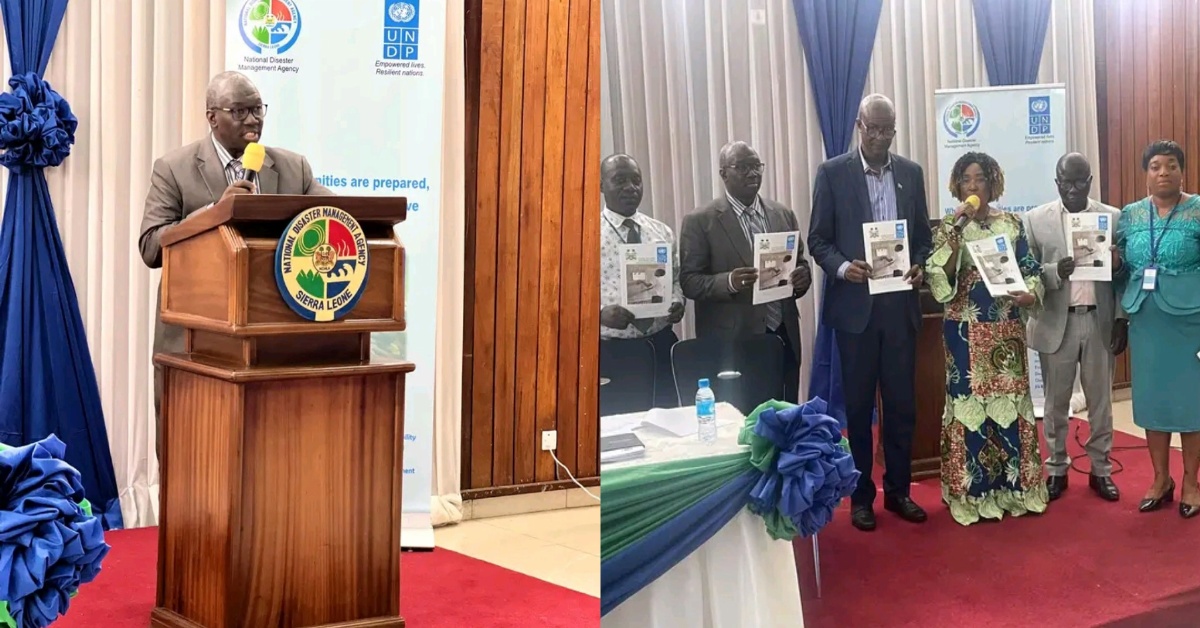The National Disaster Management Agency (NDMA), the Ministry of Basic and Senior Secondary School Education (MBSSE) and the Sierra Leone Meteorological Agency (SL Mets), with funding from the United Nations Development Program (UNDP) has launched the School Disaster Risk Reduction Teaching Guidelines (SDRRTG) and the Climate Information, Disaster Management Early Warning Systems (CIDMEWS) at the Bank Complex, Kingtom.
The School Disaster Risk Reduction Teaching Guide is designed to educate children about the various types of disasters, their causes, preventive mechanisms, and ways of responding to them. It will further facilitate the protection of children against potential disaster risks in Sierra Leone once it is included in the school curriculum.
The Climate Information, Disaster Management and Early Warning System (CIDMEWS) which is developed by the Integrated Geo-information and Environmental Management Services (Integems) a Geographic Information Systems (GIS) Web mapping application that provides easy and convenient ways to collect, map, explore, query, analyse and freely share available climate information, disaster management and early warning data and information resources from any device, anywhere, at any time.
Its primary goal is to allow people who are not GIS professionals to do self-service mapping on any device (i.e. desktops, tablets and smartphones using Internet browsers) and expand the creative use and sharing of climate information, early warning data and information resources about Sierra Leone.
Resenting the Ministry of Basic and Senior Secondary Education (MBSSE), Deputy Minister Mrs Emily Kadiatu Gogra disclosed that her ministry had closely worked with the NDMA, the UNDP and other partners to develop and validate the teaching manual which shall be included in the school curriculum. She said that in order to achieve President Bio’s safe school agenda, the ministry has developed many school-related policies and procedures, inclusive of the School Disaster Risk Reduction Teaching Guidelines.
“As a government, we care for the children, we care for the people of Sierra Leone and the development partners. This means that together we will succeed in shaping our children into what we want in terms of career building, ethical behaviours and most importantly, save them from becoming victims of disasters.” She added.
Whilst explaining the inception and development of the two products which started in 2018, the Direction General of NDMA, Lt. Gen. Rtd. Brima Bureh Sesay stated that School Disaster Management is to be carried out by the relevant authorities at all levels in collaboration with the NDMA and in accordance with international standards. He also said that the intended purpose is to maintain safety in the learning environment, whilst promoting risk education in schools across the country.
“Getting an education is a universal human right. Education enables people to exercise their rights. The right to education must not be lost or suspended due to disasters and emergencies” he added.
The Director-General furthered that the CIDMEWS will encourage collaboration of information sharing, and promote efficiency and effectiveness in providing individuals and organizations with timely and accurate climate information. This will also enable the NDMA to make an informed decision in preparedness and planning, mitigation, response and recovery. He thanked the UNDP for their continuous support in the areas of capacity building and disaster risk reduction programs, and relief and response activities.
According to the UNDP Representative, Tanzila Sankoh, Team Lead for SLED Cluster, said the two products are very key for knowledge management and disaster prevention, mitigation, response and recovery. She also stated that the products are crucial in protecting our vulnerable population, helping them plan ahead, and enabling the country to prepare for, and adapt to, the impacts of climate change.
“When a disaster occurs, children are most vulnerable because they lack the knowledge and skills to protect them from such disasters. In Sierra Leone, the frequency of natural hazards and the level of subsequent damages are significant. Schools play an important role in the formation of values that can make a significant contribution to establishing a culture of prevention. Thus, the need to increase awareness amongst the children in schools is vital in disaster prevention and management. The teaching guide will facilitate the provision of valuable information on natural hazards, disasters and reduction of associated risks amongst students and families.” She ended.
NDMA’s Deputy Director General who chaired the program explained that the two products are a result of collaborative efforts with various partners which started in 2018. He thanked the UNDP for their financial support towards the development of both products. He said that the CIDMEWS and SDRRTG are in line with international recommendations for disaster management.
“The importance of having standardized climate and early warning communication systems, and improving knowledge on disaster risks, is at the centre of the UNDRR Sendai Framework and the Africa Regional Strategy for Disaster Risk Reduction.” He stated.
Both the School Disaster Risk Reduction Teaching Guidelines and the Climate Information, Disaster Management Early Warning Systems were officially launched by the Deputy Minister of MBSSE, Mrs Emily Kadiatu Gogra.



 Post a comment
Post a comment 









